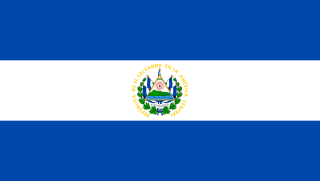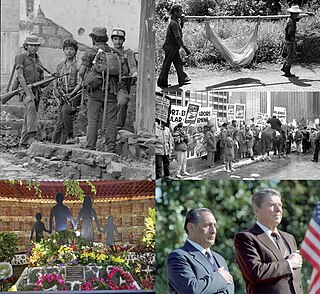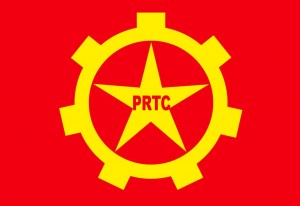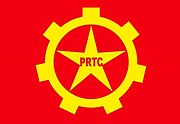
The Farabundo Martí National Liberation Front is a Salvadoran political party and former guerrilla rebel group.

The Chapultepec Peace Accords were a set of peace agreements signed on January 16, 1992, the day in which the Salvadoran Civil War ended. The treaty established peace between the Salvadoran government and the Farabundo Martí National Liberation Front (FMLN). It was signed in Chapultepec Castle, Mexico.

The Nationalist Republican Alliance is a conservative, center-right to right-wing political party of El Salvador. It was founded on 30 September 1981 by retired Salvadoran Army Major Roberto D'Aubuisson. It defines itself as a political institution constituted to defend the democratic, republican, and representative system of government, the social market economy system and nationalism.
Coordinadora Revolucionaria de Masas was a coordination of revolutionary mass organizations in El Salvador formed on January 11, 1980.
The Committee in Solidarity with the People of El Salvador, based in Washington, D.C., is a national activist organization with chapters in various cities in the United States. CISPES supports the Farabundo Martí National Liberation Front (FMLN) and the progressive social movement in El Salvador.

The Communist Party of El Salvador is a communist party in El Salvador. The Communist Party was founded by Miguel Mármol on 10 March 1930, merged into the Farabundo Martí National Liberation Front in 1995, then reestablished on 27 March 2005.

The Revolutionary Government Junta was the name of three consecutive joint civilian-military dictatorships that ruled El Salvador between 15 October 1979 and 2 May 1982.
Salvador Cayetano Carpio, also known by his nom de guerre Commander Marcial, was a Salvadoran left-wing revolutionary and the Secretary-General of the Communist Party of El Salvador in the 1960s, until his resignation from the party where he then founded the Salvadoran revolutionary political-military organization, the Farabundo Martí Popular Liberation Forces (FPL).

The Salvadoran Civil War was a twelve-year civil war in El Salvador that was fought between the government of El Salvador and the Farabundo Martí National Liberation Front (FMLN), a coalition of left-wing guerilla groups backed by the Cuban regime of Fidel Castro as well as the Soviet Union. A coup on 15 October 1979 followed by government killings of anti-coup protesters is widely seen as the start of civil war. The war did not formally end until after the collapse of the Soviet Union, when, on 16 January 1992 the Chapultepec Peace Accords were signed in Mexico City.

José Eduardo Sancho Castañeda, better known by his nom de guerre Fermán Cienfuegos, was the leader of the Salvadoran organization National Resistance Armed Forces (FARN), which was a part of National Resistance (RN).
The People's Liberation Movement was a revolutionary multisectoral mass organisation, politically tied to the Revolutionary Party of Central American Workers in El Salvador. The organisation was formed after a split from Unified Popular Action Front in May 1975 as League for Liberation. The main leaders of the organisation at the time were Manuel Federico Castillo, Nidia Diaz, Francisco Veliz and Humberto Mendoza.

Salvador Sánchez Cerén, also known by his nom de guerre Leonel González, is a Salvadoran politician who served as the 80th President of El Salvador from 2014 to 2019. He took office on 1 June 2014, after winning the 2014 presidential election as the candidate of the left-wing Farabundo Martí National Liberation Front (FMLN). He previously served as the 41st Vice President under President Mauricio Funes from 2009 to 2014. He was also a guerrilla leader in the Civil War and is the first and only ex-rebel to serve as that country's president.

The Revolutionary Party of the Central American Workers – El Salvador was a political party in El Salvador. The party was one of five constituents of the Farabundo Martí National Liberation Front during the Salvadoran Civil War.

The People's Revolutionary Army was one of five leftist guerrilla organizations that comprised the Farabundo Martí National Liberation Front (FMLN). Formed on October 10, 1980, the FMLN was one of the main participants in the Salvadoran Civil War (1979-1992).
The final offensive of 1989, also known as the ofensiva hasta el tope, was the major engagement of the Salvadoran Civil War. The battle, fought between the Farabundo Martí National Liberation Front Marxist guerrilla and the Salvadoran government, lasted from 11 November to early December 1989. Sometimes referred to as "Ofensiva fuera los fascistas. Febe Elizabeth vive", in honor of an assassinated union leader, it was the most brutal confrontation in the entire conflict, amounting for seventeen percent of the total casualties in ten years of warfare.

The Sumpul River massacre took place in Chalatenango, El Salvador on May 13, 1980 during the Salvadoran Civil War. Salvadoran Armed Forces and pro-government paramilitaries launched an offensive to disrupt the activities of the Farabundo Martí National Liberation Front (FMLN). The offensive created many refugees who were attacked the next day by the Salvadoran forces. The Honduran military prevented them from fleeing into Honduras, and between 300 and 600 refugees died. Both El Salvador and Honduras denied responsibility for the incident. In 1993, the United Nations Truth Commission described the incident as a serious violation of international law.
The 1979 Salvadoran coup d'état was a military coup d'état that occurred in El Salvador on 15 October 1979. The coup, led by young military officers, bloodlessly overthrew military President Carlos Humberto Romero and sent him into exile. The National Conciliation Party's firm grasp on power was cut, and in its place, the military established the Revolutionary Government Junta of El Salvador (JRG). The junta was composed of two military officers and three civilians.

Death squads in El Salvador were far-right paramilitary groups acting in opposition to Marxist–Leninist guerrilla forces, most notably of the Farabundo Martí National Liberation Front (FMLN), and their allies among the civilian population before, during, and after the Salvadoran Civil War. The death squads committed the vast majority of the murders and massacres during the civil war from 1979 to 1992 and were heavily aligned with the United States-backed government.
Anarchism in El Salvador reached its peak during the labour movement of the 1920s, in which anarcho-syndicalists played a leading role. The movement was subsequently suppressed by the military dictatorship before experiencing a resurgence in the 21st century.
The final offensive of 1981, also known as the general offensive of 1981, was the unsuccessful first military offensive conducted by the Farabundo Martí National Liberation Front (FMLN) during the Salvadoran Civil War. The objective of the offensive was to initiate a popular revolution to overthrow the Revolutionary Government Junta (JRG), which had been ruling the country since the 1979 Salvadoran coup d'état. The FMLN hoped that the government would be overthrown by 20 January 1981; the date Ronald Reagan was to be inaugurated as president of the United States.












